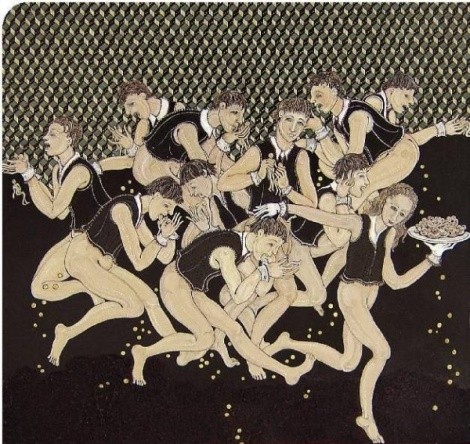
“The way to wealth and privilege
involving corporate America,”
said artist, activist and expressionist
Stephanie Wilde, “can often lead to
the greed and unconsciousness of people
in power.” This subject matter, sparked by
a personal experience, resulted in seven
years of painting. Wilde asks, in a time of
dire economic climate, “At what point did
the moral compass go off track in corporate
America with those who are in positions of
power?”
The new exhibition at the Salt Lake
Art Center, Harmed, is a manifestation of
Wilde’s seven-year journey, focusing on
issues of economic abuse, “documenting a
trial that we are going through,” she says.
Her art addresses universal phenomena,
drawn from her own experience. The exhibition
displays 48 paintings grouped in
small installations—narratives that convey
different aspects of what Wilde views
as “corporate injustice.” These narratives
originate from a vantage point that is very
much her own and a passion of palpable
authenticity.
The work began in 2002 shortly after
Wilde was witness to signs of economic
devastation in her own community of Boise.
Through idle gossip, she had been made
aware of a situation that involved a local
CEO and his wife “obsessed with power,”
she said. This made her “wonder what it
was that made them feel that it was perfectly
all right to have these behaviors,” but
also, said Wilde, “I wondered that people
never questioned it.” From this incident,
the empowered artist/activist/expressionist
began a seven-year project addressing
the core of this corruption, choosing to act
beyond idle gossip.
The result of this empowerment can be
seen in Wilde’s manner of painting and
in the motifs in each installation she created
for this body of work. Wilde said, “The
visual language is obvious and the narratives
are very intentional and very blatant.”
There is nothing equivocal in the content of
Wilde’s work or her conviction to the topic
she is confronting.
Two primary installations dominate
the show and relate aspects of Wilde’s
perspective of the corporate “moral compass,”
yet all 48 paintings are united by a
common aim. The first major grouping is
comprised of five panels collectively titled
“Falling.” These are canvases with crudely
rendered, contorted anonymous figures
with little detail, set against a
background of black—the depths they
are plunged into. They appear to be
victims to their fate.
“These are the people who are harmed, falling into the abyss,” said Wilde. “When you look at people, there is no way to see that they have lost their retirement, lost their jobs, been laid off; they don’t have any physical harm. Theirs is financial and psychological harm, so I stripped them naked. They do not have anything left.”
These images have an archaic, nightmarish,
medieval quality. This resonates notions
of a barbaric and unsympathetic, compassionless
corporate entity to which Wilde
attributes responsibility for the “fall.”
The second of the primary installations
is titled “Harmed,” a grouping composed of
13 canvases. The central panel is an utterly
chaotic mass of bodies wearing white collars,
black vests and white gloves, naked
from the waist down. They are, says the
artist, “eating small little people being
served up as hors d’oeuvres, and then defecating
money.” Nothing is subtle here.
These archaic and abject images are
a frenzy of carnivorous gluttony. They
seem to be in a perpetual state of lust and
insatiable desire to consume, and all logic
or reason is absent. In its place is greed
and selfishness. Maintaining the medieval
sensibility, the figures are contorted
and reminiscent of a Dante-like scene of
purgatory. The allegory is a bold statement,
exemplifying Wilde’s uninhibited
directness towards her artistic, activist
expression.
Wilde has a history of artistic activism,
and her art has always had “a social and
political direction,” she says. After having
a son with a rare blood disorder, Wilde’s
art began to reflect the AIDS epidemic,
in America and especially Africa, where
she traveled. Her subject matter for a time
also dealt with the significance of 9/11. But
events in her own town of Boise became the
catalyst for her art that would sustain her
energies subsequently and can now be seen
at the art center.
Ultimately, Wilde hopes that if anything
is to be gleaned from her seven years of passionate
and aggressive labor, it will be, she
says, “to engage the viewer with a greater
sense of responsibility.” In the age of Enron
and Ponzi schemes, handouts and foreclosures,
the substance of Wilde’s work and her
inventive compositions are timely and they
stress, says Wilde, an “awareness of human
frailties and self-awareness of our culture,
especially our financial culture.”
HARMED
Salt Lake Art Center
20 S. West Temple
801-328-4201
Through October 10
www.slartcenter.org